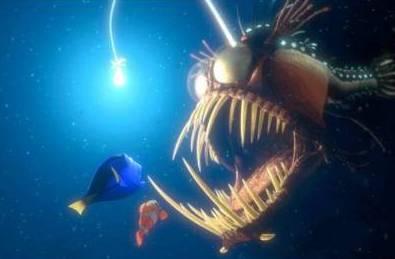Design inspiration for the metal anglerfish puzzle model: In "Finding Nemo," there's a large, ugly fish with a glowing "fishing rod lantern" on its head. It has a huge mouth and needle-sharp teeth, with exaggerated facial expressions. This is our protagonist today, the anglerfish from the depths of the ocean at 500-5000 meters.

A peculiar appearance with an astonishingly large appetite.
When they are young, they are surrounded by a gelatinous membrane that provides protection. They float like small bubbles on the sea surface until they grow up, when they can only move slowly on the seabed like an old grandmother.

The anglerfish has an unusually large and flat head, a wide mouth, small pelvic fins, and highly developed pectoral fins that it uses like feet to walk on the seabed. It primarily feeds on various small fish or fry, as well as various invertebrates and even sharks, thanks to its enormous mouth and similarly astonishing appetite.

The secret of bioluminescence?
The highlight of anglerfish is the organ shaped like a fishing rod protruding from their nose. This organ, filled with bioluminescent bacteria, emits light to lure small fish as prey.

The reason why the "little lantern" emits light is because it has gland cells inside the lantern that can secrete luciferin. Luciferin undergoes slow chemical oxidation with oxygen catalyzed by luciferase, resulting in bioluminescence. Many fish in the deep sea exhibit phototaxis, making the "little lantern" an advantageous tool for anglerfish to lure prey.

In fact, many fish species, like fireflies, have the ability to emit light. Different fish emit distinct bioluminescent signals; they use these lights to communicate within their own species, deceive other fish into becoming prey, or evade predators. The light emitted by fish is mostly blue or blue-green, but some emit light in pale red, light yellow, yellow-green, orange-purple, or blue-white hues. Among them, anglerfish have the highest bioluminescent capability, emitting light in various colors such as yellow, yellow-green, blue-green, and orange-yellow.
Unwavering love
The anglerfish is famous not only for its lantern-like organ on its head but also for its mating habits. When scientists first discovered them, they noticed that nearly all individuals appeared to be female. Eventually, scientists found that the "parasites" on the female's body were actually "miniature" male anglerfish.

Male anglerfish are extremely small, losing their digestive systems once they reach a size suitable for mating. In one species of anglerfish, males can be as small as 0.25 inches (approximately 6.35 millimeters), making them one of the smallest known vertebrates. In contrast, females can be up to 50 times larger than males. Anglerfish are known for their "faithfulness" in love, practicing monogamy where one male pairs with one female. Their breeding season typically occurs in spring and summer.
The eggs produced by females can cluster together to form gelatinous sheets measuring 9 meters long and 3 meters wide. Such egg masses can float on the sea surface until the larvae hatch.

Once they reach a certain stage of development, male anglerfish will seek out a suitable female, biting into her abdominal tissue and attaching themselves to her. The female's tissue grows rapidly, quickly enveloping the male. Eventually, the female descends to the seabed with the male parasitically attached to her, and they begin to enjoy their sweet "two-fish world" together.
If you're a marine life enthusiast, our metal anglerfish puzzle model is sure to pique your interest and leave a lasting impression on you.




